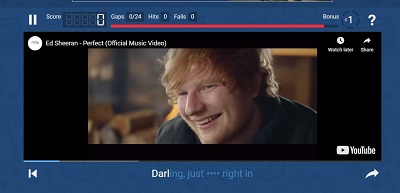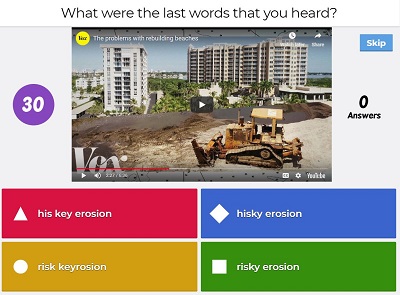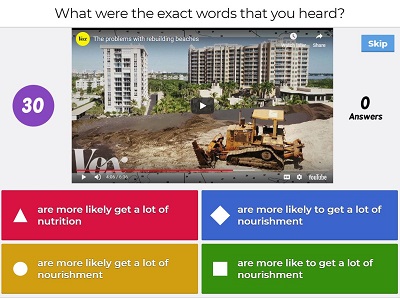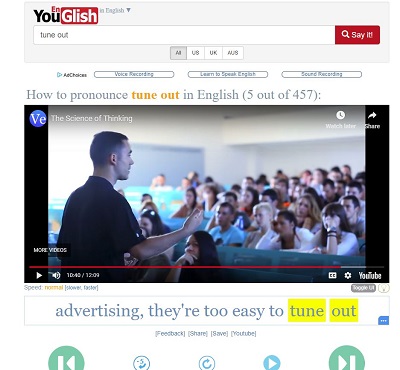|
If you’ve ever taught a class in which you’ve needed to teach
students’ listening comprehension, you are probably familiar with the
tried-and-true comprehension approach to teaching listening:
- Students listen to an audio or video clip and take notes.
- Students answer comprehension questions about the prompt.
- You and your students review the answers together.
- You and your students may discuss the reason that students didn’t get the answers right.
When your students inevitably ask you for more specific advice
about how they can improve their listening, your best advice may be to
“just listen more.” You might direct them to websites for English
learners, or TED Talks, or certain learning apps. But perhaps you’re
wondering what else you could be doing in your class to help students
improve their perception of spoken English, not just their exposure to
spoken English.
Now, of course, your students should be
“listening more.” In fact, in his book Listening in the
Language Classroom, Field (2008) affirms that an extensive
listening approach is one key element of a balanced approach to teach
second language (L2) listening in the classroom. However, you should
also incorporate a process approach—which favors repeated listening of a
prompt and a close examination of the sounds of a spoken text (Field,
2008, pp. 111–112)—as well as a diagnostic approach, which takes note of
the common errors in listening perception that your students make
(Field, 2008, p. 84).
In practical terms, a process approach in the classroom
incorporates explicit bottom-up listening instruction, which provides
practice in segmenting authentic connected speech. In his research,
Field (2008) found that only 25% of participants, who were intermediate
learners at approximately CEFR B1, were able to accurately recognize
known words in a string of connected speech during a paused
transcription activity (p. 289). In other words, “L2 listeners succeeded
in decoding far less of the linguistic input than their teachers
assumed…it appears that the ability to recognize
known vocabulary and syntax may fall well behind the ability to produce
it” (Field, 2008, p. 289). In fact, as Vandergrift and Goh (2012) point
out, L2 listeners often have difficulty recognizing known words when
those words occur in connected speech.
So what should you do? How can you incorporate bottom-up
listening activities and ear-training skills to help your students
improve their ability to understand connected speech? In this article,
I’d like to draw your attention to three digital technologies that you
can use for such purposes: Lyricstraining, Kahoot!, and
Youglish.
Lyricstraining.com
Imagine watching an episode of Friends or
watching the music video to Ed Sheeran’s “Perfect” on your computer. At
the bottom of the screen is the transcript. However, there are some
missing words. As you listen, you enter the words based on what you
hear.

That’s Lyrictraining.com. It’s a
website and an app that allows students to engage their bottom-up
listening skills. Students can use Lyricstraining individually as an
app, or you can display an exercise that the class completes together.
Although the website does not yet have the functionality for teachers to
assign exercises to students individually, you can challenge students
to log on at home and practice their listening by selecting any number
of songs, movies, or TV shows. It’s a free website, so give it a
try!
Kahoot!
Kahoot! has
become wildly popular in language education because it offers a
streamlined way for teachers to gamify any class. Listening is no
exception. In Kahoot!, you can add a segment of a video clip from
YouTube and create questions about that clip. To test bottom-up
listening skills, you will need to strategically choose where you start
and stop the video. This is why interactive transcripts of videos, such
as those that are available with TED Talks, can help you save time in
looking for teachable moments in videos. Once you find a segment that
represents the specific challenge in listening perception that you want
to focus on, you can click directly on the TED Talk transcript, and you
will be redirected to that moment in the video.


One common perceptual challenge that Field (2008) points out is
linking between a consonant-final word and a word that begins with a
vowel, such as made over, which can sound like may dover. In one of my games, I linked a question to
a segment that included the words, it’s based on a sense of
false security. My distractors were based on a sense
of fall security and base dawn on a sense of fall
security. You might also choose to create questions that focus
on students’ ability to recognize known vocabulary in a video clip or
hear word endings that indicate plurals or certain verb tenses.
Youglish.com
Youglish is a
search engine that allows the user to find a specific word or phrase in
thousands of YouTube videos, making it a perfect tool for students to
increase their exposure to specific known vocabulary. After entering
search terms, the website automatically queues thousands of videos in
which that word or phrase is spoken. By simply pressing the forward
button, the student can quickly hear and compare how that word or phrase
sounds in many different contexts through the voices of many speakers,
making it a particularly useful tool for self-study.

If you’d like to see a demonstration of these digital
technologies in action, please take a look at the instructional
video that I’ve created on this topic.
I think it’s important to
point out that teaching L2 listening can be particularly challenging
because there is a dearth of research into the actual processes that L2
learners use to make sense of the target language (Vandergrift, 2007).
In TESOL teacher training programs, methods for teaching skill-based
speaking and listening classes tend to more heavily emphasize
preparation for teaching speaking and pronunciation. As a result, when
new teachers enter the ESL/EFL classroom, they often rely on the
approach that their textbook dictates, perhaps because they are
unfamiliar with any other way to teach listening. However, as digital
technologies continue to advance, more and more opportunities are
emerging for gamifying the classroom and encouraging autonomous
learning.
References
Field, J. (2008). Listening in the language
classroom. Cambridge, England: Cambridge University
Press.
Vandergrift, L. (2007). Recent developments in second and
foreign language listening comprehension research. Language
Teaching, 40(3), 191–210. doi:10.1017/S0261444807004338
Vandergrift, L., & Goh, C. (2012). Teaching and
learning second language listening: Metacognition in action. New York,
NY: Routledge.
Sharon Tjaden-Glass is an instructor for the
Intensive English Program at the University of Dayton. She is also a
coeditor for the newsletter of TESOL’s Intercultural Communication
Interest Section. |

